High mass star cluster formation
A mix of review & some recent results
Adam Ginsburg
Jansky Fellow, NRAO Socorro
This presentation can be found at https://tinyurl.com/HMCFormationTTF18
What is a high-mass cluster?
- Gravitationally bound collection of stars that survives the loss of gas
- Collection of coeval stars that 'fully samples' the IMF
- Clusters where interactions are important
- Portegies-Zwart 2016, Vincke+ 2016, Gemma Busquet's talk earlier
- Around \(10^4~\mathrm{M}_\odot \), \(v_{esc} \gtrsim10\) km s\(^{-1}\), so ionization alone does not disrupt gas

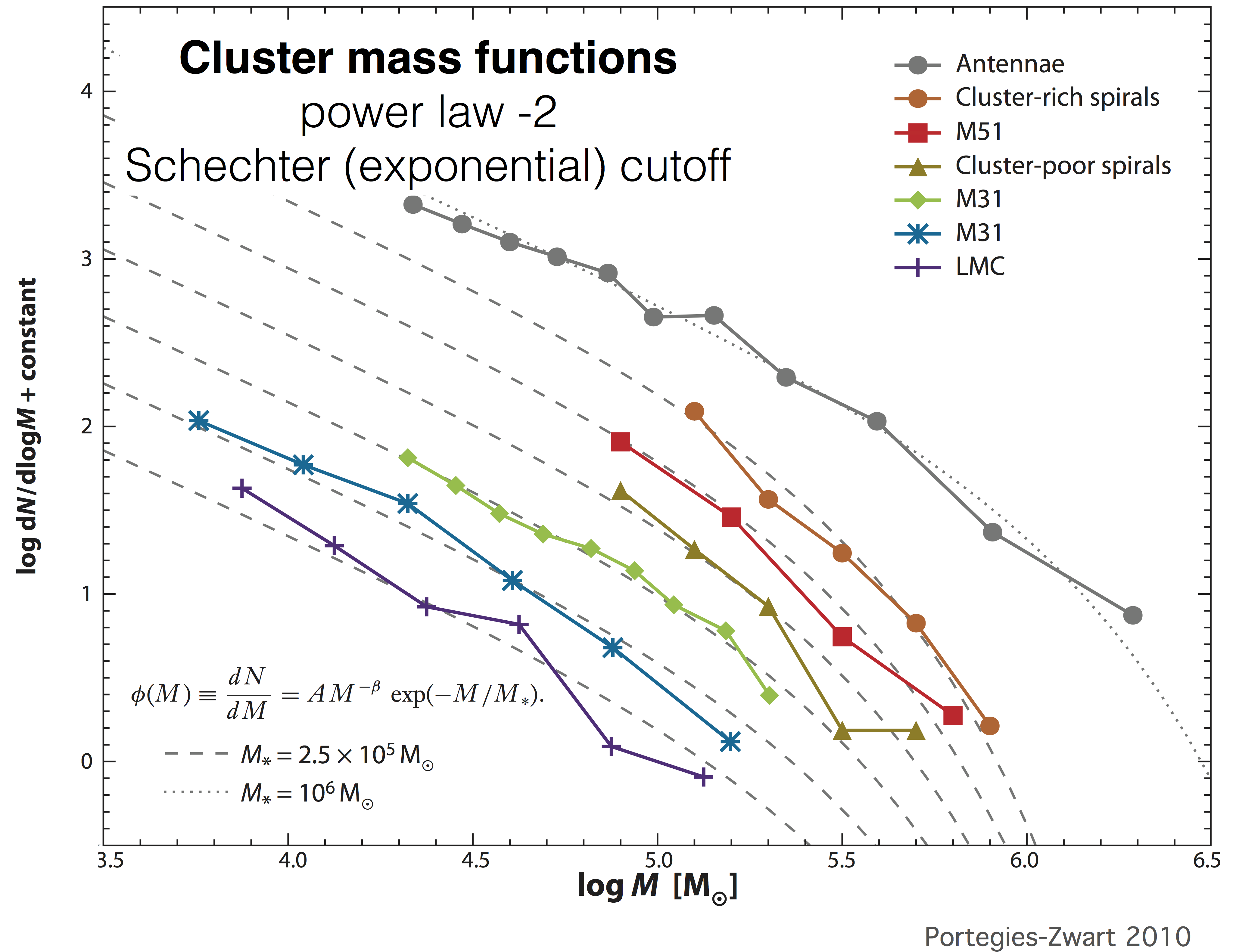
Upper mass cutoff varies with Galactic radius in M83
YMCs are the best local analogs
of proto-Globular Clusters
- and they're pretty good analogs
- GCs probe Galaxy formation histories
- Open questions in GC populations to address with YMCs:
- How does the power-law cluster MF evolve to a peaked one?
Low-mass get destroyed, e.g. Kruijssen 2012
- How do GCs form? i.e., how should we form GCs in simulations?
- Why do GCs contain MSPs?
(what are MSPs)
- How does the power-law cluster MF evolve to a peaked one?
MSPs in GCs
- MSPs = Multiple Stellar Populations,
as opposed to SSPs = Simple (or Single) Stellar Populations
- Distinct sub-populations exist within most or all globular clusters that are younger and/or chemically different
- Bastian & Lardo 2017 ARAA review:
"Many scenarios have been suggested to explain [MSPs], with most invoking multiple epochs of star formation within the cluster", but most of these fail
Observations:
Forming high-mass clusters in the Galaxy
- Galactic plane surveys find few (~10s) of high-mass protoclusters
- Ginsburg+ 2012, Urquhart+ 2014a, b, 2018, Longmore+ 2014, 2017 Contreras+ 2017
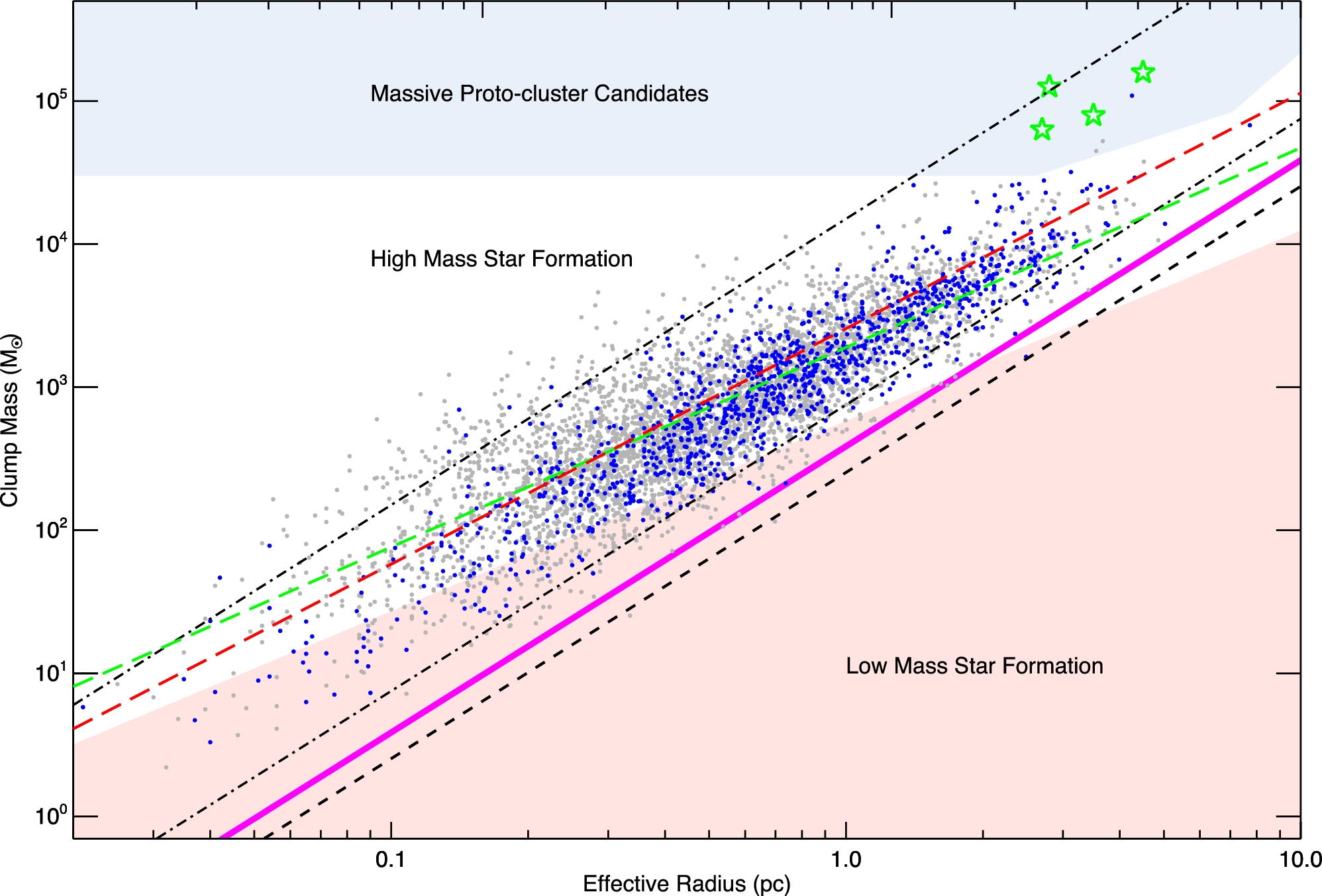
How many are there?
- SFR \(\times\) CFE:
\( \left(2~M_\odot~\mathrm{yr}^{-1}\right) \left(0.07^{+0.07}_{-0.03}\right) f_{(>10^4\mathrm{M}_\odot)} / \left(M_{cl,10^4 M_\odot}\right)\)\(= 3-12~\mathrm{clusters~Myr}^{-1}\)(Galactic CFE from Lada & Lada 2003, Goddard+ 2010, Kruijssen 2012; \(f_{(>10^4\mathrm{M}_\odot)} = 0.4\)
- Observed: 12-18 currently forming YMCs
(excluding CMZ)- Fewer (~2) if more conservative SFE ~10% is used
- Observable protocluster lifetime ~0.2-1 Myr
YMCs form fast
- Age spreads in YMCs are small, <1 Myr
- There are no signs of starless proto-YMC clumps
- Ginsburg+ 2012, Urquhart+ 2018
- Urquhart+ 2018 estimate the 'quiescent' phase is \(<2.4\times10^4 \mathrm{yr}\) for \(M>10^4 \mathrm{M}_\odot\)
- YMCs are gas-free by ~a few Myr
Is star formation in high-mass clusters different?
- The IMF should depend on density, feedback (e.g., Jones & Bate 2018, \(M_c \propto \rho^{-1/5}\) )
- Feedback from one star affects many in clustered regions
- Total star formation efficiency is higher. SFEff may be higher?
- Collisions assemble the most massive stars?
(e.g., Fujii+ & PZ 2013, but see Moeckel & Clarke 2011)
-
Interactions certainly affect disks (e.g., Wijnen+ 2017, Vincke+ 2016)
-
How do massive clusters get their mass?
- The mass is pre-assembled in "starless" clumps, then collapses
- The mass is assembled as stars form: there is no starless phase, gas comes from larger scales
- Better supported by observational timescale arguments
- "Conveyor Belt" of Longmore+ 2014
- Stars form in substructures, then merge into clusters
(e.g., Fujii+ 2012)
YMCs start large, collapse to small
- Gennaro+ 2017: Westerlund 1 is collapsing
- Walker+ 2015: gas is more extended than stellar cluster
Caveat: Sgr B2 is optically thick, might be much denser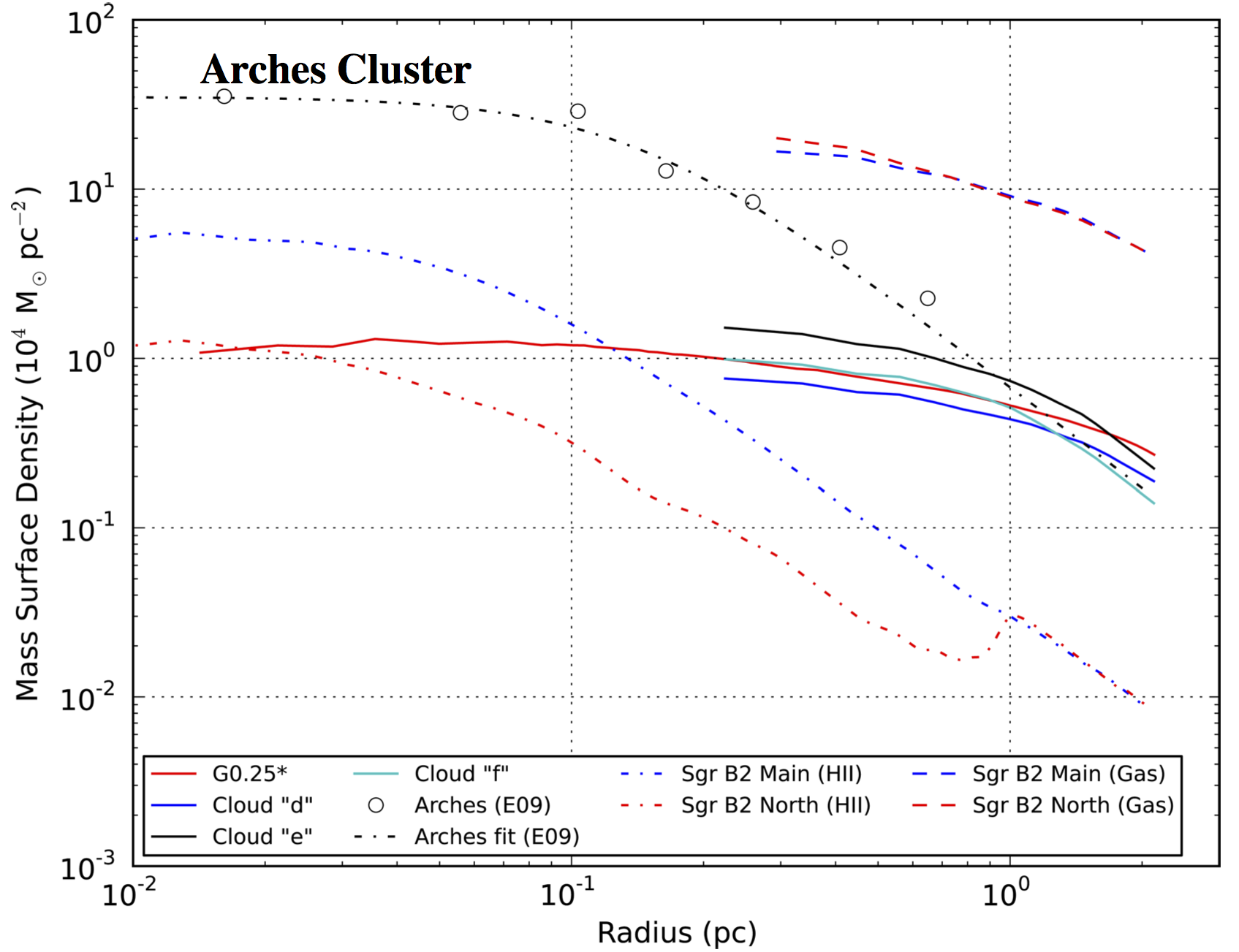
Simulation: Accretion from large scales
Observations: Infall toward PMCs
Feedback and Efficiency
- Feedback appears ineffective at halting SF on small, dense scales
- Ionization-bounded HII regions are smaller, less massive: HCHII regions ionize small amounts of gas that does not escape
-
For high \(v_{esc}\) regions, mass loss can only occur via stellar winds, jets, radiation pressure, and champagne flows
(e.g., Bressert+2012, Matzner & Jumper 2015)
- Winds are ineffective (Rosen+ 2014, Lopez+ 2014)
In simulations of smaller clouds, Geen+ (2018) found factor of ~3-5 variation in efficiency purely from IMF sampling stochasticityW51 IRS 2: Ionization is eroding gas inefficiently
Photoevaporation rate \(\dot{M}_{pe}< 0.001 \mathrm{~M}_\odot \mathrm{yr}^{-1}\)
Star Formation Rate \(\dot{M}_{sf}\sim \epsilon_{ff} M_{gas} / t_{ff} \) \(= 2000 \mathrm{M}_\odot / 10^4 \mathrm{yr}\) \(=0.2 \epsilon_{ff}\mathrm{M}_\odot \mathrm{yr}^{-1}\)
Even for \(\epsilon_{ff} = 0.01\), \(\dot{M}_{sf} > \dot{M}_{pe}\)
\(\dot{M}_{pe}\) consistent with Kim, Kim, & Ostriker 2018 for \(M_{cluster}\sim2-10\times10^3 M_\odot\)Feedback is effective on cloud scales (e.g., Haid talk earlier)Structure of forming clusters
- Stars form in subtructures in the gas (e.g., filaments)
- Merging substructures smooth out, become more symmetric
- Parker & Dale 2015, Goodwin & Whitworth 2004, Grudić+ 2017
- There is debate about how long this takes and how it is affected by the presence of gas
- A consequence is that it is not immediately obvious which forming stars will become cluster members
W51: X-ray stars
W51: X-ray stars
W51: X-ray stars + Cores and UCHII regions
W51: Cores and UCHII regions
Cluster Formation Efficiency revisited
- What fraction of all stars form in bound clusters?
- Not all do (e.g., Bressert+ 2010, Ward & Kruijssen 2018)
- Varies with environment, increasing toward higher density
- More stars formed in higher density regions in the early universe, so more in clusters
- We can measure this locally, given an appropriate change in environment
Talks by Lu, Battersby, Walker, Zeng; posters by Butterfield, Callanan, Hatchfield, Henshaw
Sgr B2: Most massive cloud + protoclusters
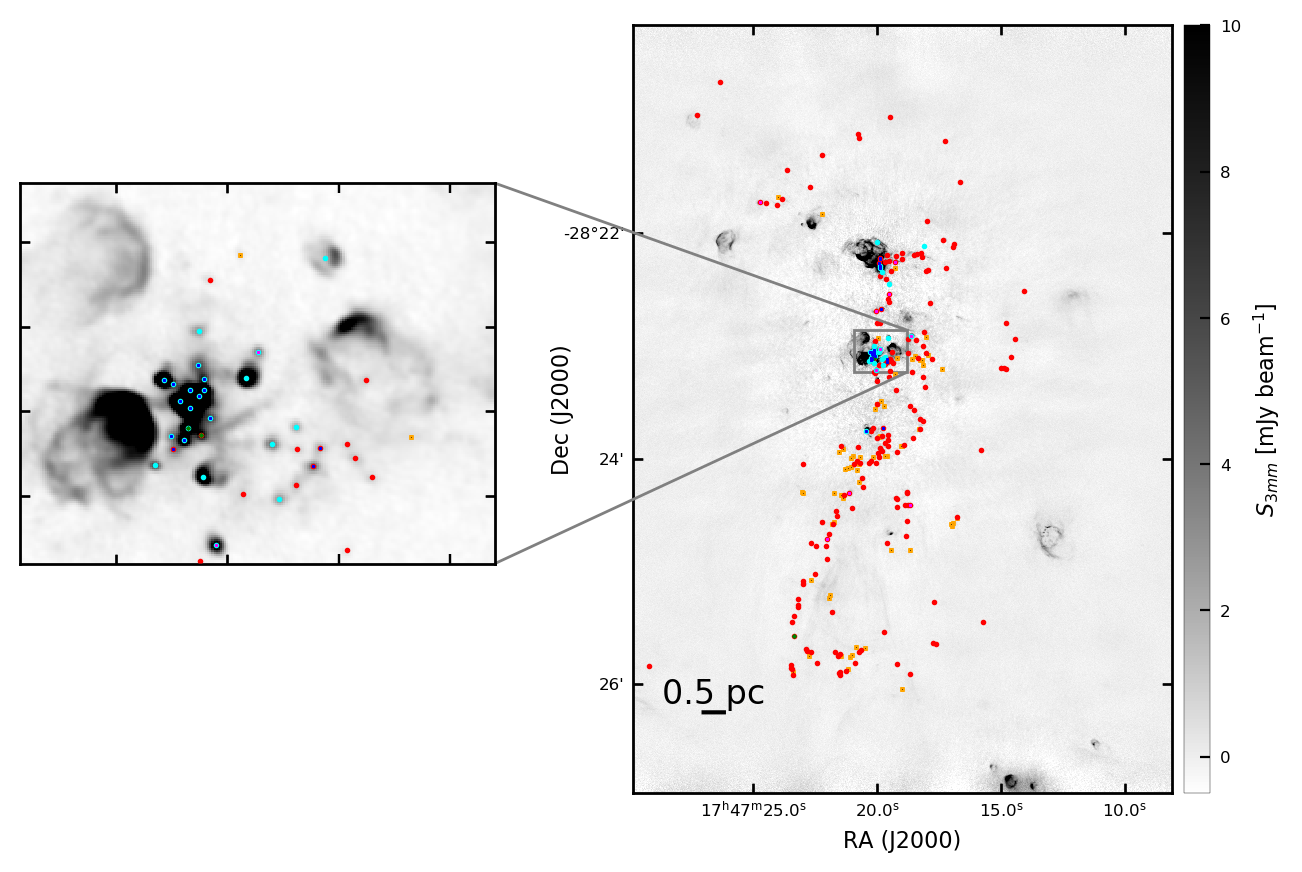 Tightly bound cluster: \(\sigma_{1D} \sim 9-12~\mathrm{km~s}^{-1} \) \(\sigma_{1D} < v_{esc} \sim 14~\mathrm{km~s}^{-1}\) from RRL LOS velocitiesClustered and unclustered star formation occur together (Ginsburg+ 2018)
Tightly bound cluster: \(\sigma_{1D} \sim 9-12~\mathrm{km~s}^{-1} \) \(\sigma_{1D} < v_{esc} \sim 14~\mathrm{km~s}^{-1}\) from RRL LOS velocitiesClustered and unclustered star formation occur together (Ginsburg+ 2018)High-mass cluster formation: Sgr B2
The Cluster Formation Efficiency (CFE) is a function of density (Kruijssen 2012).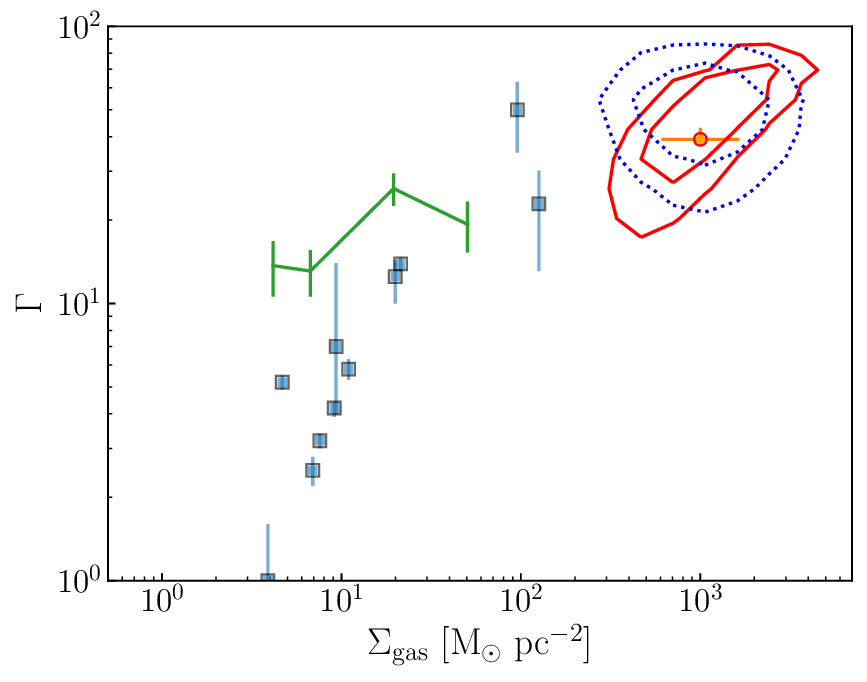 Sgr B2 fits the predictions(Ginsburg & Kruijssen, in prep).
Sgr B2 fits the predictions(Ginsburg & Kruijssen, in prep).Sgr B2 N: Collapse
Collapse is morphologically obvious, but very difficult to measure (Peretto's talk): continuum is optically thick on ~1000 AU scales (Schwörer, Ginsburg, Schilke+ in prep)Fragmentation appears suppressed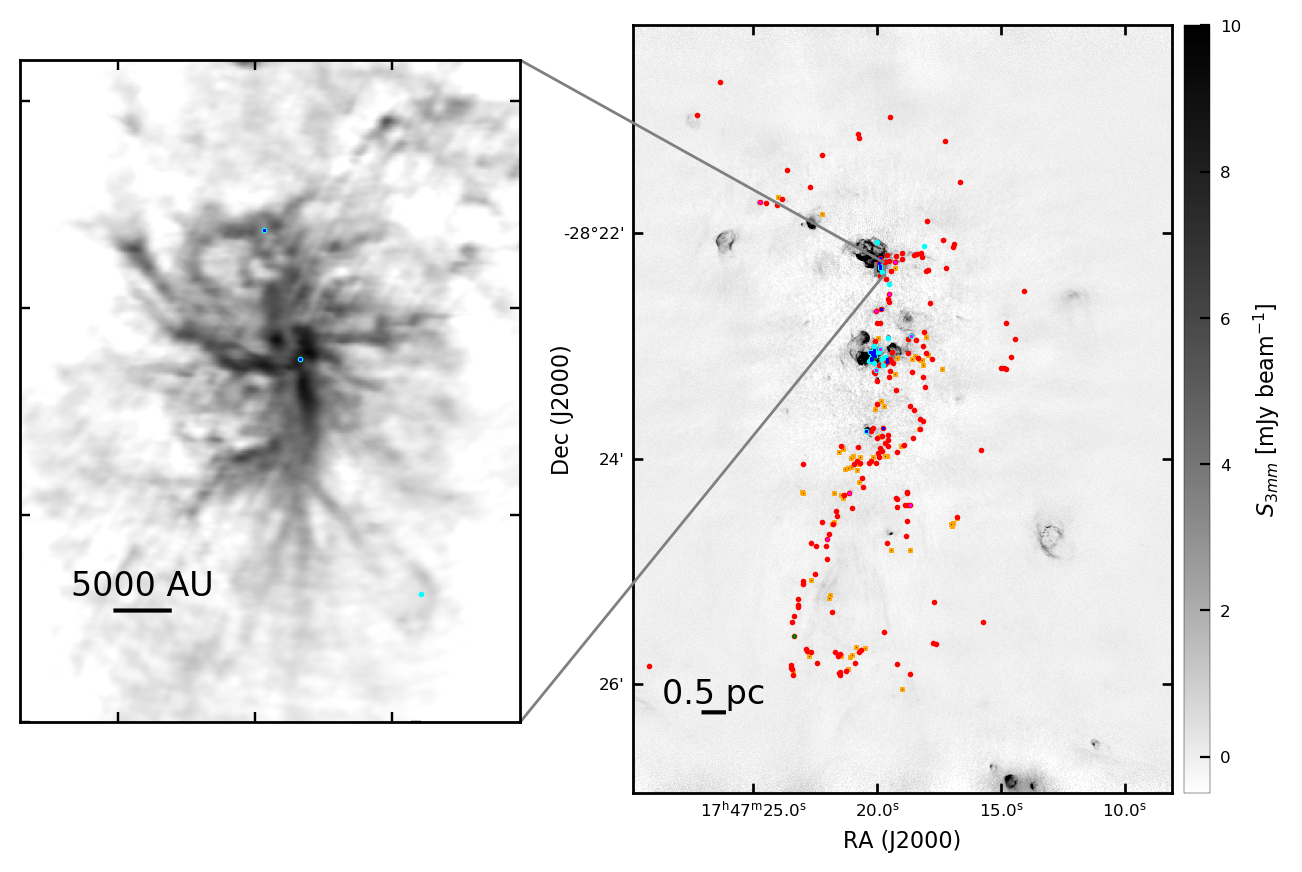
Summary
- YMCs are important tools to understand Globular Cluster formation
- They are at least in part assembled from larger scales and merging subclusters
- More stars form in bound clusters at higher density
- Within forming clusters, feedback from the most massive stars affects neighbors, suppressing fragmentation
Future Directions
- Complete census of spatial and mass distribution of protostars from the ALMA-IMF program
- A direct connection between the protostellar and stellar populations with JWST imaging and spectroscopy to pierce the extinction layers
Credits: Peter Williams, git, reveal.js, MathJax, pdf.js
- Observed: 12-18 currently forming YMCs
